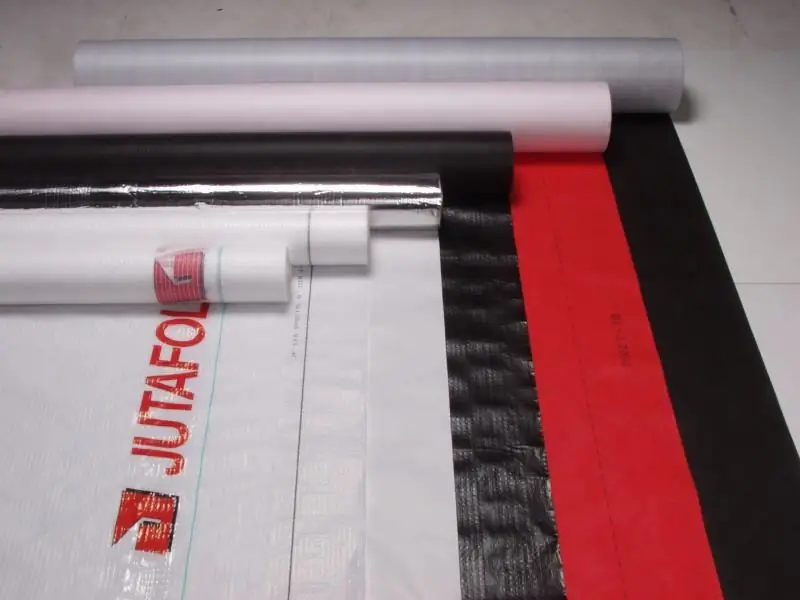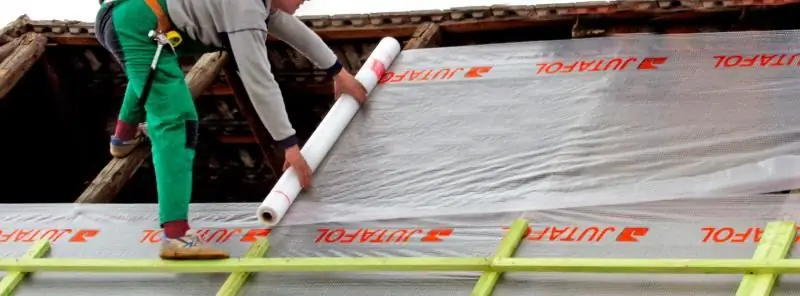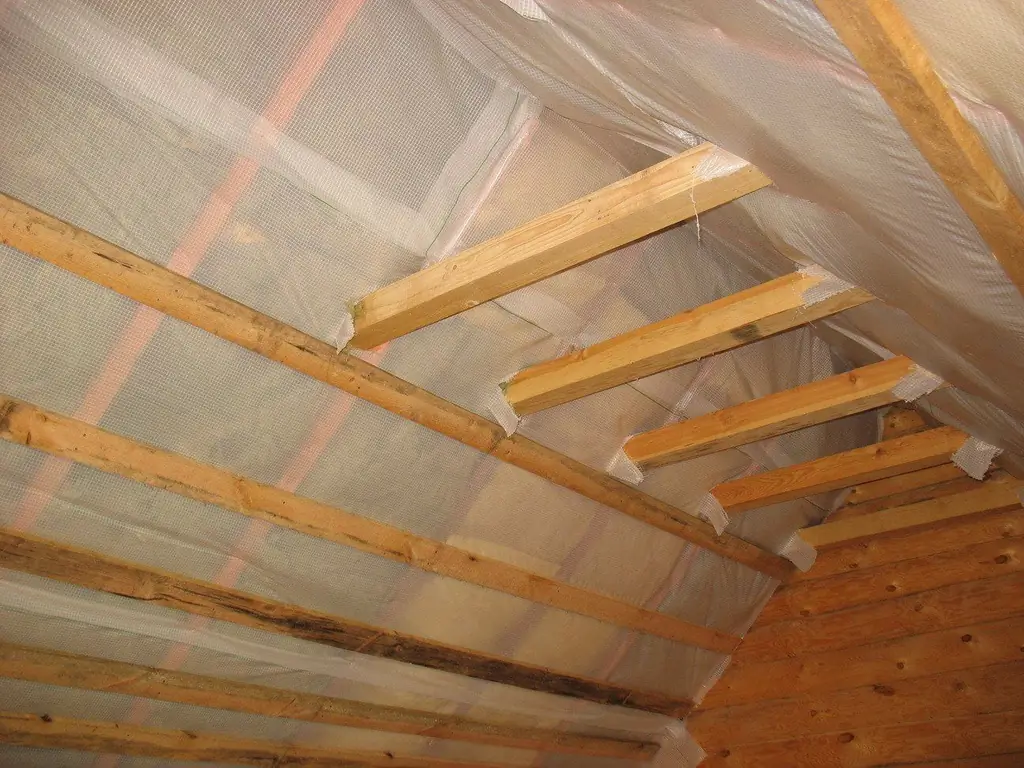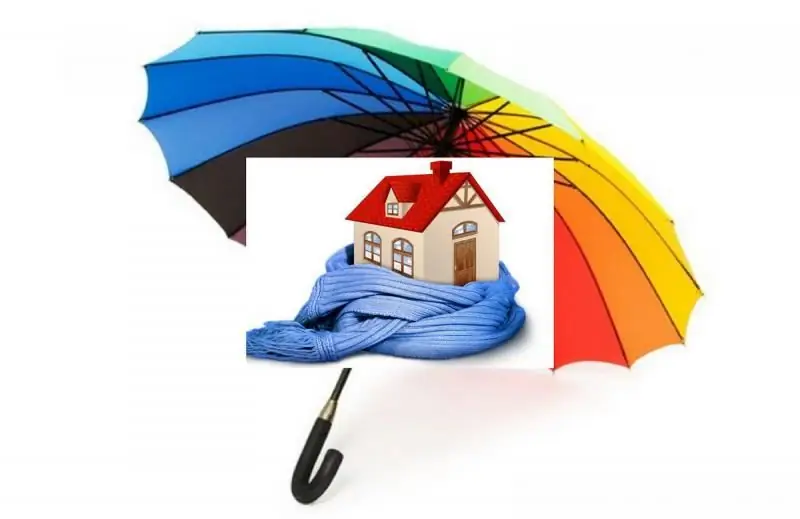
Table of contents:
- Author Bailey Albertson [email protected].
- Public 2023-12-17 12:53.
- Last modified 2025-06-01 07:32.
Roof vapor barrier and its types

Vapor barrier is a building material, which is almost impossible to do without when equipping the roof of a house. After all, it protects the building from condensation, vapors, and moisture. In addition, a well-chosen vapor barrier maintains a normal microclimate and humidity in the rooms of the house, extends the life of the interior decoration and retains heat.
Content
-
1 Types of roof vapor barrier with description and characteristics
- 1.1 Roll vapor barrier
- 1.2 Sheet vapor barrier
-
2 Materials for vapor barrier
- 2.1 Vapor barrier or polyethylene film
- 2.2 Vapor barrier or polypropylene material
- 2.3 Diffusion membranes
- 3 Leading manufacturers of vapor barrier products for roofs
-
4 Device Methods
- 4.1 Paint shop
- 4.2 Oleechnaya
-
5 Installation of vapor barrier
5.1 Video: DIY installation of a roof vapor barrier
-
6 The main violations of the laying of vapor barrier material
6.1 Video: mistakes when laying a vapor barrier
Types of roof vapor barrier with description and characteristics
There are two main types of vapor barrier material for roofing: sheet and roll.
Roll-up vapor barrier
Roll roofing materials are divided into classes depending on the components, thickness and quality.
- The premium class is a bitumen-polymer vapor barrier made of the highest quality raw materials. At the same time, modern cleaning technologies and expensive equipment are used. This type of vapor barrier is used even in industry, in harsh climatic conditions. Premium waterproofing is manufactured in accordance with GOST.
- Business class is quite reliable product, but not as durable. Moreover, they are also used in difficult climatic conditions. These materials can be distinguished by their mechanical and physical properties. In addition, the business class vapor barrier roll has such significant properties as heat resistance, endurance under significant water pressure, as well as high density and flexibility. Vapor barrier of various classes is distinguished by the thickness of the sheet in the roll, therefore, when purchasing the material, specify the initial ideal thickness of the coating, which will suit your particular case.
- The standard materials are rolls for roofing that protect the structure from water, but they cannot be used in all climates. They are not as durable as previous modifications, but in terms of quality and cost, they can be called the best. The main disadvantage of this class of vapor barrier is the impossibility of their use on roofs with a large slope.
-
Economy class is the most affordable way to protect a building. The material is installed in cases where its density, thickness and service life are unimportant, and the main selection parameter is cost.

Roll-up vapor barrier for roofs Leading manufacturers of roof vapor control systems produce a wide range of roll-type products of all classes
Sheet vapor barrier
Sheet vapor barrier is used in conditions with significant power loads, in other words, where other types of materials can collapse. When installing sheet vapor barrier, it is necessary to glue the seams well, otherwise damage to the entire roof structure cannot be avoided. In terms of its properties, this type of material does not differ from roll insulation, the only difference is in the method of installation and the manufacturer.

Installation of sheet vapor barrier is carried out under heavy loads on the roof
Vapor barrier materials
On the modern market, vapor barrier materials are presented in a wide variety. They differ in characteristics, strength, and thickness. What is now used as a vapor barrier for the roof:
-
foil-clad reflective materials;

Foil vapor barrier Reflective foil vapor barrier for roofs is most often used in saunas and timber frame houses
-
high density polyethylene film;

Vapor barrier polyethylene film Dense polyethylene film is one of the most affordable vapor barrier options
-
modern analogue of polypropylene materials;

Polypropylene vapor barrier Polypropylene films have higher strength and tolerate temperature changes well
-
non-woven breathable membrane.

Breathable vapor barrier membrane When using non-woven "breathable" membranes, there is no need for a ventilation gap
Let's consider the main advantages of each of the mentioned types of vapor barrier materials.
Vapor barrier or polyethylene film
It is a material that prevents the "cake" of the roof from the ingress of condensate, water and steam. In addition, the film can bring these vapors upward. The roof insulation is protected from dampness and soaking from both sides simultaneously:
- bottom - due to vapor barrier;
- top - vapor-permeable membrane.
The steam that rises upward in the rooms is not allowed through by the vapor barrier material, and accumulated in the insulation quickly leaves through the membrane to the outside. Polyethylene film is mainly purchased due to its following advantages:
- Excellent strength as well as elasticity. Thanks to these characteristics, the film does not break.
- Ease of installation - the blade is in excellent contact with various fasteners.
-
Immunity to all kinds of mechanical stress. The polyethylene film remains intact even if the roof structure breaks. At the same time, she continues to keep the insulation on the rafters.

Roof vapor barrier with polyethylene film Polyethylene successfully combines affordability, strength and elasticity
A vapor barrier film is made of polypropylene or polyethylene. Polyethylene is not a very durable material, therefore it is specially reinforced with reinforcing mesh or fibers. There is a film with or without perforation.
Perforated foil is more often used as waterproofing than vapor barrier. When using a perforated film as a vapor barrier, its installation is carried out outward by perforation, that is, with the smooth side to the insulation, and the rough side to the rooms. If the installation goes wrong, water will penetrate inside, and steam will not be able to go up. This is the main reason that the roof first begins to leak and then rot for no apparent reason. Do not use thin and very cheap materials for such purposes, since they have a short service life and unsatisfactory quality.

Durable perforated polyethylene vapor barrier will only provide the desired effect when installed in the correct direction
When equipping a metal roof, use only material that burns weakly as a hydro and vapor barrier layer.
Vapor barrier or polypropylene material
This is a more versatile and modern roof arrangement option. In essence, the vapor barrier resembles a reinforcing mesh, which is made of polypropylene with special strength. The main task of the material is high vapor insulation. This fabric, laminated on both sides with a polypropylene layer, is highly resistant and resistant to UV radiation. At the same time, there are canvases that are treated with special antioxidants that do not allow condensation to appear.

Polypropylene film resembles perforated polyethylene, but is much more durable
Materials with antioxidants not only absorb, but also retain water until it evaporates due to ventilation. In these types of film, the smooth side is the front, the rough side is the wrong side.
It is easy to install the material - the joints of the vapor barrier are glued with a special tape made on the basis of butyl or acrylic. The material is laid with an interference fit without sagging. The material is attached to non-planed wood using polyurethane or acrylic mixtures, as well as synthetic rubber. In this case, sealing tapes or tape will not help. But it is possible to attach to metal beams precisely thanks to the double-sided tape. The areas that you are going to glue are reinforced with a clamping bar.

The joints of the layers of the vapor barrier film are glued with a special construction tape
Foil film with a smooth, continuous texture, due to its excellent characteristics such as economy, high reliability, and practicality, can claim to be an ideal option for arranging a barrier. In addition, there are no cracks or seams on it, which means that the film retains moisture perfectly. The reflective effect helps to retain heat in the premises, which does not allow warm air to escape. However, these are not all the advantages of foil film:
- no bloom and mold appear on this material;
- the film can comfortably cover large surfaces;
- no need to use special equipment for mounting the material;
- low cost;
- foil creates an excellent barrier against rainfall on the insulation;
-
the material is easily cut into fragments of any configuration.

Foil material for vapor barrier Reflective foil material is great for roof vapor barrier and helps retain heat in the room
Previously, ordinary foil was used, which is a rather fragile material, therefore it breaks from any pressure. The manufacturers removed this disadvantage and created the material from several layers: aluminum spraying and a strong, flexible base.
This type of steam insulation material retains more than 70% of the heat. It is securely attached to any surface, for example, to a tree - with a stapler, to concrete - with an assembly tape. Among other things, the foil film perfectly withstands any high and low temperatures.
Diffusion membranes
This type of material appeared on the market several years ago. Made from non-woven and synthetic material, this ventilated membrane is highly vapor-permeable, but moisture-tight. Its main advantage is that it allows you to abandon the arrangement of a gap for ventilation under the roof. Diffusion membranes are much more effective than various polypropylene and polyethylene films. However, their price is much higher.
Diffusion membranes are divided into:
-
Conventional diffusion - this material is called polypropylene or polyethylene perforated film. In terms of vapor permeable characteristics, they are significantly inferior to the second type of membranes, whose indicator per day ranges from 400 to 1300 g / m 2. That is why, when installing them, it is necessary to make ventilation gaps, which will prevent the "greenhouse effect" from occurring. In the production of diffusion membranes, "Spunbond" technology is used. In this case, materials with a two-layer structure are used (cellulose, polyethylene, and so on). Diffusion membranes are used in the construction of vapor barrier in attics, since at temperatures below minus 25 degrees, water will begin to freeze in their pores.

Diffusion film for roof vapor barrier Diffusion films allow steam to pass in one direction and retain moisture in the opposite direction
-
Superdiffusion - the vapor permeability of this material per day is on average 1200 g / m 2. It is usually laid directly on the insulation, which not only simplifies installation, but also reduces the thickness of the roofing cake. If mineral wool is used, the superdiffusion membrane also serves as wind protection. This material consists of three layers, and is used not only for soft, but also for hard roofs.

Super diffusion membrane for vapor control Superdiffusion membrane fits directly onto the insulation and protects it from steam and wind
The principle of operation of the membrane is very simple - steam passing through the material settles on a rough surface. Then it is absorbed and dries, while the insulation remains intact and dry. The film is two- and one-sided. The latter type fits exclusively according to a certain technology on the insulation, the first - whatever you like.
Leading manufacturers of vapor barrier products for roofing
When arranging the roof, the ideal result can be obtained from special vapor barrier materials, however, when choosing them, the manufacturer's brand plays a significant role.
-
"Yutafol" - the advantages of these materials include versatility, resistance to installation, better ventilation, excellent service life, as well as resistance to mold. Several products stand out in the line of this manufacturer:
- "Yutafol Special" series H110 with a reinforced mesh to give the vapor barrier strength a layer of lamination applied on both sides. The membrane contains a special reagent that gives the material low flammability. The density is 110 g / m 3;
- film "Yutafol Standard" has similar properties to the previous product, but it does not have a self-extinguishing reagent;
- the four-layer "NAL Special" series 170 already comes with an aluminum layer, but only on one side. The density is 170 g / m 3.
-
"TechnoNikol" - produces the most popular material now, which is fireproof, environmentally friendly and meets safety standards and GOST. The three-layer structure of the material protects the roof from condensation, dust, and also absorbs noise. Vapor barrier "TechnoNicol" shows excellent strength and resistance to moisture.

Film "TechnoNicol" for roof vapor barrier Fireproof and environmentally friendly film "TechnoNikol" has a three-layer structure and is intended for roof vapor barrier
-
"Izospan" - the advantages of the products of this company include environmental friendliness, ease of installation, the ability to operate in a wide temperature range (-60 … + 80 o C), resistance to mold and mildew, high water-repellent properties and strength. The service life is up to 50 years.

Vapor barrier film "Izospan" The company "Izospan" is one of the leaders in the market of vapor barrier materials
-
"Ecolife" - a two-layer structure of the material is able to retain water droplets on its rough surface with their subsequent evaporation. The second side of the Ecolife vapor barrier is water-repellent. Advantages: high tensile strength, resistance to bacteria and chemicals, no toxic emissions, ease of use.

Ecolife film for vapor barrier Ecolife roof vapor barrier film has high water-repellent characteristics and resistance to chemicals
Device methods
The roof vapor barrier device completely depends on which option was chosen for the necessary work.
Paint shop
According to this technology, steam insulation on the roof is carried out using well-heated bituminous mastic, polyvinyl chloride varnishes, as well as chlorinated rubber, asphalt, bitumen-kuersol and bitumen-lingosulfonate mastics. These materials are ideal for roofs made of steel profiled sheets and for those where insulation is not required to be installed.
Before laying the paint vapor barrier, the surface must be well cleaned of dust, dirt, and then dried. Grout is used to eliminate all existing irregularities. After that, the mastic is evenly applied, and not a single segment on the surface should be missed.
Vertical sections on the roof (ventilation ducts, attic walls, etc.) are also covered with this material to a height of about 20 cm. The mastic is applied in a heated state to a temperature of:
- 200 ° C - bituminous rubber;
- 70 ° C - gudrokamovaya;
- 160 ° C - tar;
-
180 ° C - bituminous.

Vapor barrier paint system Paint vapor barrier is made in cases where it is not required to insulate the roof
Okleechnaya
Insulation of the roof from steam must be done with modern materials, which are produced in rolls. This packaging provides many advantages:
- the number of seams decreases;
- when overlapping, the edges are connected tightly;
- installation is much easier.
Arrangement of a roof with a vapor barrier using a film is called a pasting method. The material is arranged according to the following principle: if the air humidity inside the building does not exceed 70%, the film is installed in one layer, if the value is higher, then in two.
The material is laid according to the principle of installation of roll products. Construction tape is used to seal the protective layer and seal all edges.

At the junction, the sheets of film are overlapped and glued with a special tape
Installation of vapor barrier
Installing a vapor barrier is a responsible task that must be completed in stages. Before that, you need to prepare the following tools:
- nylon cord;
- scissors;
- adhesive tape;
- nails with large diameter heads;
- marker;
- a hammer;
- clamping strips;
- roulette;
- stapler with staples;
- electric drill.
After that, you can proceed with the installation:
- The first step is to decide how you will install the vapor barrier. Install the material in a horizontal position from the top of the roof. For vertical installation - no special requirements.
-
Lay a piece of vapor barrier sheet with the smooth side to the rafter beams. Install from the attic side.

Fastening the vapor barrier film The vapor barrier film is attached from the attic side
- Drive nails into wooden parts through the vapor barrier membrane. To simplify and also speed up this stage of work, a furniture stapler can be used instead of nails.
- Attach the next piece of material to the rafter legs so that there is an overlap of 10 cm with the first piece.
-
Seal the seams resulting from the contact of the two segments with adhesive tape. When laying the vapor barrier along the beams and in the absence of a rough insulation on them, the film segments are superimposed on each other only at the rafters.

Vapor barrier film on the roof The vapor barrier film is attached to the roof rafters from inside the room
-
Use the clamping strips to fix the bonding areas of the vapor barrier. These fasteners must be used when installing a roof with a slope of 30 o and more, as well as in cases where the installed insulation has insufficient density. In places where hatches or skylights pass, use the vapor barrier apron included in the kit.

Vapor barrier apron for roof windows The vapor barrier is laid in the grooves of the roof window and then fixed in the usual way using a stapler or nails.
-
Fix thin wooden slats on the film material, which must be pre-treated with a special antiseptic. In this case, the distance between them should be about 50 cm. Thus, a crate is created that fixes the finishing material. As a result, there will be a gap (2-5 cm) between the interior trim of the roof and the vapor barrier material, which is needed for natural ventilation.

Roofing scheme The battens of the battens fix the vapor barrier film, form a ventilation gap and serve as a frame for attaching the finish
Video: DIY roof vapor barrier installation
The main violations of the laying of vapor barrier material
Ignorance and lack of experience in laying a vapor barrier can lead to some mistakes in the arrangement of the roof:
- the presence of unconsolidated areas at the points of contact of the film with beams, girders, as well as crossbars and ridge, where it is necessary to fasten wooden slats;
- using tape less than 5 cm wide. The recommended thickness of the adhesive tape is 10 cm, while it perfectly connects the edges of two pieces of material;
- lack of a 3 cm film reserve when arranging window openings;
- incomplete closure of the vapor barrier around the roof windows with finishing materials, which leads to the destruction of the film by ultraviolet rays;
- use of scotch tape where the vapor barrier touches the inner walls. The walls have a rough surface, so the scotch tape cannot reliably connect to fix the film on them. Usually, for such work, they use glue made of synthetic rubber, acrylic or polyurethane mixtures;
- wrapping the vapor barrier around the rafters - the film must be laid exclusively on top of them, otherwise moisture will accumulate in the space between the rafters and the vapor barrier.
Video: mistakes when laying a vapor barrier
When deciding which vapor barrier to buy for the roof of your house, it is necessary to take into account not only the cost of the material, but also its durability, ease of installation, strength, as well as the effectiveness of steam shielding. The service life of the material should be equal to that of the roofing deck. The final choice depends on your wallet size and preference.
Recommended:
Roof Membrane, Its Types And Brands With Description, Characteristics And Reviews, As Well As Installation Features

What is a roofing membrane. What types of membranes are used in the construction of various roofs. Membrane brands and features of their installation
Polycarbonate For The Roof And Its Types With A Description, Characteristics And Features Of Installation And Operation

Polycarbonate and its types. How to choose polycarbonate for your roof. Features of storage and installation, service life. Consumer reviews
Installation Of Roof Vapor Barrier, How To Do It Right, Including Which Side To Put On The Roof

Why do you need a vapor barrier and what materials can be used. Rules for arranging a roof vapor barrier: how to avoid mistakes. Photo and video
Thermal Insulation Of The Roof And Its Types With A Description And Characteristics, As Well As Features Of Materials And Installation

Description of the types of roof insulation, as well as the main materials for insulation and their properties. How to properly install thermal insulation on the roof and how to work
Roof Insulation And Its Types, As Well As The Materials Used With A Description And Characteristics

Roof insulation and its types. Why do you need heat, hydro and sound insulation of the roof. What materials are used to protect the roof and how to install them correctly
